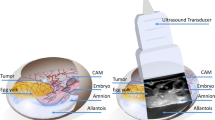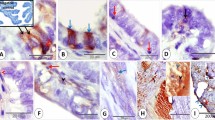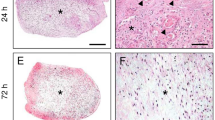Abstract
CHORIOCARCINOMA is a highly invasive tumour that retains some of the peculiar properties of normal immature human trophoblast1. In order to study the manner in which it invades tissues, we inoculated small fragments of transplantable human choriocarcinoma into the following sites in 19 young (70–90 g) female Syrian hamsters (Dennen): uterine broad ligament, peritoneal cavity, lung, liver, brain, thigh muscle, vena cava, hepatic portal vein, and internal jugular vein. Testicular inoculation was carried out in one male hamster. The tumour used was the Greene choriocarcinoma (kindly supplied by Dr. Roy Hertz), originally isolated in 1960 by Roy Hertz, carried by serial passage in the hamster cheek pouch, and similar in behaviour to the WO strain described by Hertz2. Although cortisone is not needed to maintain growth of the Greene choriocarcinoma in the cheek pouch, we gave it to 15 of the 19 hamsters in this preliminary work with the hope of ensuring tumour growth at the various inoculated sites3. For direct implantation into organs, two–ten 3-mm tumour fragments were inoculated into each site by cannula (Lundy–Irving caudal needle). For intravenous inoculation, the tumour was minced with Bard Parker knives into fragments less than 1 mm in diameter. About 50 of these tiny fragments were suspended in 0.1 ml. or less of Gey's balanced salt solution, and slowly injected with a tuberculin syringe through a 21-gauge hypodermic needle. All hamsters were autopsied within 7–16 days.
This is a preview of subscription content, access via your institution
Access options
Subscribe to this journal
Receive 51 print issues and online access
$199.00 per year
only $3.90 per issue
Buy this article
- Purchase on Springer Link
- Instant access to full article PDF
Prices may be subject to local taxes which are calculated during checkout
Similar content being viewed by others
References
Hertig, A. T., and Mansell, H., Tumors of the Female Sex Organs. Part 1— Hydatidiform Mole and Choriocarcinoma. Fasc. 33, Section IX, Atlas of Tumor Pathology (Armed Forces Institute of Pathology, Washington, D.C., 1956).
Hertz, R., Proc. Soc. Exp. Biol. and Med., 102, 77 (1959).
Zeidman, I., Proc. Amer. Assoc. Cancer Res., 3, 281 (1961).
Tedeschi, L. G., and Tedeschi, C. G., Arch. Path., 76, 387 (1963).
Hertz, R., and Greene, H. (personal communication).
Kirby, D. R. S., Nature, 187, 707 (1960).
Kirby, D. R. S., Nature, 194, 785 (1962).
Kirby, D. R. S., J. Reprod. Fertil., 5, 1 (1963).
Kirby, D. R. S., J. Anat., 97, 119 (1963).
Kirby, D. R. S., Nature, 194, 696 (1962).
Author information
Authors and Affiliations
Rights and permissions
About this article
Cite this article
EHRMANN, R., GLISERMAN, L. Choriocarcinoma: Growth Patterns in Hamster Tissues. Nature 202, 404–406 (1964). https://doi.org/10.1038/202404b0
Issue Date:
DOI: https://doi.org/10.1038/202404b0
Comments
By submitting a comment you agree to abide by our Terms and Community Guidelines. If you find something abusive or that does not comply with our terms or guidelines please flag it as inappropriate.



